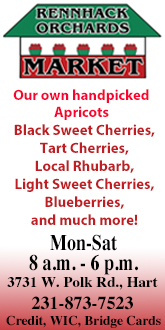Locally Made.
By Kate Krieger. MCP Senior Correspondent.
As a native of Ludington, I thought it would be a great idea to feature many area businesses that I had either grown up with or businesses that I had become familiar with in the more recent years of my life. I wanted to promote what the businesses had to offer the local area in a series I call “Locally Made.”
Seeing that I was a local, I figured I probably already knew a lot of what these places offered to locals and tourists alike. Boy, was I wrong. Being a local doesn’t mean much unless you really take the time to get to know your own community, so I’m finally taking the time to get to know my community and what it offers the rest of the world….
AMBER TWP – I know honey comes from bees, but I was not very aware of how honey is really made. I can easily go online and look up how bees create honey, but I decided that actually visiting a beekeeper would probably be a better idea. I know there are differences in bees and only honeybees obviously make honey, but I have no real idea of what all these bees do to produce their honey. I met with Dan and Theresa Rohde at Ludington Honey on South Gordon Road to pick Dan’s brain about bees and how he processes local honey.
In 2007, Rohde started with five colonies of bees that he purchased from a dealer out of Holland, who bought the bees from Georgia. By the end of his first year he had caught more swarms bringing his number of colonies to 12. Currently, Rohde has 45 colonies.
 “I had as many as 70,” he says. “I’m currently sitting at 45. The last two winters really killed us and the past winter was a real bad one.”
“I had as many as 70,” he says. “I’m currently sitting at 45. The last two winters really killed us and the past winter was a real bad one.”
Rohde says keeping bees alive in Michigan isn’t the easiest thing to do because of a parasitic mite that weakens the immune systems of the honeybees. There are more organic methods to treat the mites including Thymol, a pesticide derived from the thyme plant, which Rohde says is sort of a Vasoline texture and Hopguard, which comes from hop plants.
Rohde tries to be as natural as possible with his beekeeping and honey processing, although he stated many people blame the pesticides for the death of many honeybees, but he doesn’t believe that to be totally true.
“Scientists can’t find the smoking gun,” he says. “There are a number of things causing the bees to die, including the mites. I wouldn’t point my finger at the pesticides. People are really pushing that it’s the real culprit, but I don’t buy it.”
As for the bees themselves, there are a lot of steps they go through in order to make honey that is ready to be collected and bottled by Rohde.
Honeybees are considered a superorganism, which means they cannot survive without the entire colony. The queen bee controls the colonies and the worker bees are all female and there are approximately 99 percent female worker bees to one percent male drone bees in each colony. A queen can lay up to 2,500 eggs per day and after 21 days, each egg will develop into a grown bee. The average lifespan of a worker bee in the summer is about five weeks.
The colonies tend to split in the spring when they become too large and this process consists of the old queen and 50 percent of the worker bees leaving, looking for a new location to start a new colony. They will create a new cluster and send out scout bees to find their new home. When the new colony is established in its new location, it is not uncommon for that colony to be made up of 30,000 bees. The bees will unpack their honey stomachs, which they have filled with as much honey as possible due to the unknown of when they will find a new home. After reaching their new home, the bees will release the honey into honeycombs, which is later the honey that is collected as part of the honey Rohde processes and bottles for resale.
Rohde will start to pull honeycomb near the end of the summer, he stated that he knows when it’s time when the goldenrod plant begins to bloom. He also stated that goldenrod doesn’t make for good honey to eat, but the bees will feed on the goldenrod-based honey during the winter months in order to stay alive.
Each box Rohde uses contains 10 frames of honeycomb and they each can be pulled out individually for inspection of the bees and honey progression. Every colony has two deep boxes that they start off with and then shorter honey super boxes are placed on top of the original two boxes, making an extension for the bees to produce more honey. At the end of the summer, Rohde will shave off the wax that has been placed on the honeycomb by the bees when each cell has been filled. He then spins the honey in a specific machine, which makes the honey fly out and it then runs out a spicket for collection.
The honey is heated to 90 to 100 degrees and run through two different tanks. The first tank takes out particles and the second tank will find any other particles and those particles will float to the top where Rohde will remove them.
The honey is never heated over the temperature of the actual hive and shouldn’t really exceed 110 degrees. Rohde says most of the honey sold in stores has been pasteurized and filtered a lot more, making for a longer shelf life and not as natural taste. He then bottles the honey for resale.
Rohde sells anywhere from two-ounce honey bears to five-pound jars of honey and prices range from four to 20 dollars. He will also sell the honeycomb while it is in season as well. Ludington Honey products can be purchased locally at Grassa’s Farm Market and The Evergreen Natural Food Store.
“Every year is getting better,” Rohde says. “People buy it once and if they like it they seem to keep coming back.”
Ludington Honey is one of the only licensed honey houses in Mason County and Rohde really prides himself in the work he does.
I can now say that I know so much more about honey making and honeybees. One thing I find very interesting about honeybees is that they really aren’t aggressive and that they aren’t likely to sing people nearly as much as the other types of bees, especially the yellow jacket. I will never view bees in the same light now knowing there are so many different types and even though many people think all bees make honey, the honeybee is the only type that actually does. Its orange and black coloring is very distinctive and the next time I see one, instead of swatting it away, I will take into consideration all it goes through in its short life to make such an amazing tasting product.

















































.png)















 (1).gif)